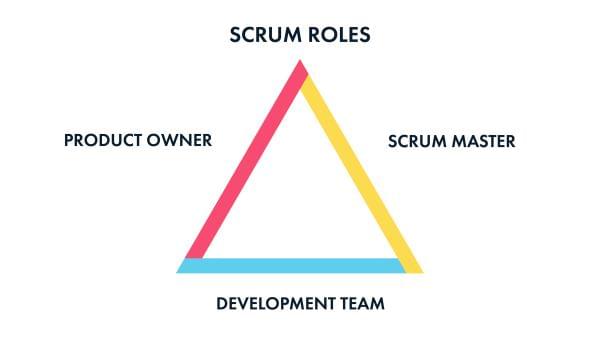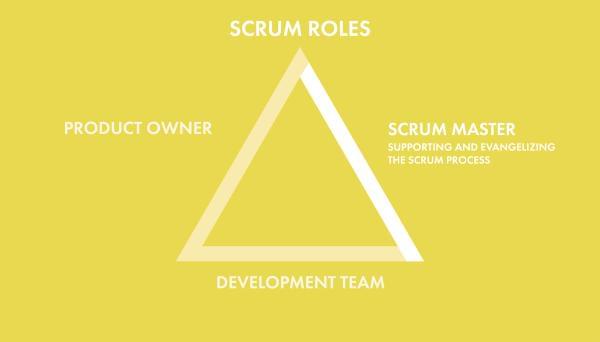
The following is an extract from our book, Scrum: Novice to Ninja, written by M. David Green. Copies are sold in stores worldwide, or you can buy it in ebook form here.
Scrum is a system that supports sustained productivity for a team. But if you try to adopt scrum, and don’t give adequate consideration to the purpose of each of the roles that scrum assigns to the participants, you’re likely to find problems maintaining the balance and rhythm of scrum. Cutting corners on the defined roles is one of the most prevalent anti-patterns in scrum, and it’s easily avoided by making the assignment of roles deliberate and explicit.
Traditional scrum defines only three critical roles: scrum master, product owner, and team member. We’ll start with these. But scrum plays out in a context, and for web and mobile development, that context is usually a company or organization trying to create technical embodiments of experiences for clients, users, or customers.
No Hierarchy
An agile scrum team operates within an organization that may have a hierarchy of management. But the roles in scrum are all equals as far as the process is concerned.

Although the title may sound imposing, the scrum master has no authority other than the leadership demonstrated in the role of servant leader for the scrum process. The product owner has no authority other than maintaining the vision of the product and shepherding it through the scrum process. And the team has no authority other than the power to estimate, accept, reject, commit to, work on, and complete stories. And everyone should be empowered to enforce these roles to preserve an agile work environment.
Note: A servant leader?
The term servant leader is often used when discussing the delicately balanced position a scrum master occupies. The scrum master has no formal authority over anything other than the rituals and artifacts of scrum, but leads the team from within by embracing and evangelizing the concepts of scrum. A scrum master serves the needs of the entire team—helping to eliminate blockers (impediments to the scrum workflow) and coaching people about how to follow the practices of scrum—and should lead by example when advocating for and defending scrum.
Scrum Roles and Organizational Roles
The roles of scrum are independent of the formal job titles that may be assigned and managed as part of the hierarchy of a company. For some teams, this can cause confusion over how the people who aren’t part of the formal agile process fit into the process. Nobody outside the scrum team really needs to understand scrum for it to work. But an important part of scrum is transparency, and the activities of a scrum team may draw outside attention.
In this chapter, we’ll go over the critical roles of scrum master, product owner, and team member. In addition, we’ll discuss the motivations and perspectives of many people outside the scrum team whose involvement may have an effect on how well scrum works, and may ultimately be the key to advocating for and maintaining scrum in an organization.
Scrum Master

A scrum master is the glue that ties a scrum team together. Scrum masters are responsible for keeping people clear on their roles, managing the rituals and artifacts of scrum (which we’ll be getting to shortly), and coaching people within the team and across the organization to help overcome blockers and maintain a sustainable productive pace.
Unlike project managers, a scrum master comes with a clearly defined mission as a servant leader to the team. A scrum master has no formal authority within an organization, other than the authority to shepherd the team through the rituals of scrum, and maintain the artifacts that track the team’s progress. But the scrum master has ultimate authority when it comes to the scrum process and how it’s being applied.
Note: The Scrum Master’s Involvement
The scrum master may be a part of the development team, but just as often a scrum master may have no involvement in the day-to-day development work of the team. For teams who have been following scrum practices for a while, and who are comfortable with scrum, a single scrum master with no development duties may be able to take responsibility simultaneously for two teams.
Warning: The Scrum Master’s Responsibilities
A scrum master is usually part of the Engineering department, and in some cases may be a member of the development team. It’s a conflict of interest for a scrum master to be the manager of the people on a development team. A scrum master should have no formal organizational authority over the team, otherwise the team may feel inhibited about raising issues with the scrum master because of the potential ramifications.
Responsibilities
There are a few critical rituals that a scrum master must observe. At minimum, these include the daily standup, the sprint planning meeting, the end-of-sprint demo, and the sprint retrospective. We’ll be going into more detail about these rituals soon.
In addition to hosting the rituals of scrum, a scrum master is responsible for coaching the team through the scrum process. This may involve stepping boldly into discussions about individual roles and duties, and helping people communicate their needs and expectations in a way that makes them understandable. In that sense, a scrum master can become a team’s advocate, counselor, and liaison to other parts of the organization.
Scrum masters also maintain a number of artifacts that help the team stay focused on their goals and measure the sustainability of their progress toward their commitments. These artifacts, and the data they contain, may be subject to broad interpretation both within the team and outside it, so a scrum master needs to be capable of explaining the state of the team and its progress in terms that are understandable to a wide range of audiences, both within and outside the organization if needed.
A Day in the Life
Scrum masters need to be involved in every aspect of product development, so they have to work closely with many people and deal with a number of critical tools—as illustrated in the following list. (Don’t worry if there are some unfamiliar terms in here at this point. We’ll be discussing the artifacts and rituals of scrum soon.) So, their activities include:
-
planning and hosting the rituals of scrum, including the daily standup, the sprint planning meeting, the sprint demo, and the sprint retrospective
-
assisting the team in identifying blockers that get in the way of their development work
-
soliciting help from team members, product owners, or anyone in the organization who can help remove blockers and get stories going again
-
maintaining the artifacts of scrum and making sure everyone has access to them
-
coaching team members about their roles and responsibilities, while watching for problems and helping to resolve them
-
working with the product owner to help clarify stories and maintain a well-groomed backlog
-
representing the needs of scrum to management and across the organization for the sake of the product and the team.
One ritual that every scrum master will try to host on a daily basis is the fifteen-minute standup with the entire team, and any guests who care to observe. For some teams, this will happen early in the day, while other teams prefer to do it later.
Scrum masters will likely be involved in a number of follow-up discussions at the end of the standup. The most important ones will involve removing blockers from team members who cannot move forward without coordinated assistance. Scrum masters will also meet with constituents such as product owners and team members to follow up on any other issues that were raised during the standup.
On days when other rituals are scheduled, such as the sprint planning meeting, the sprint demo, or the sprint retrospective, the scrum master leads the process, making sure all the steps the team has agreed to are followed, and that the time constraints are honored.
Updating the artifacts of scrum is the daily duty of the scrum master. These are always maintained in a state that allows anyone to see at a glance what the team is working on, to support the essential transparency that keeps scrum working. This includes calculating and reporting on team metrics such as velocity, and clarifying the relevance of these concepts to people outside the team.
Scrum masters also play a key role in supporting the scrum responsibilities of every member of the team. A scrum master needs to be available to coach the team when issues arise, and to recognize these issues when they manifest. This can mean helping the product owner figure out how to phrase a story for the backlog, observing and participating in a pairing session with developers to facilitate the process, or preparing reports on the team’s status in plain language—for the sake of people who aren’t on the team but who need to understand what’s happening.
Frequently Asked Questions (FAQs) about Scrum Master Role
What are the key responsibilities of a Scrum Master?
A Scrum Master is primarily responsible for ensuring that the team follows Scrum principles and practices. They act as a facilitator between the team and the product owner, helping to manage communication and resolve any issues or obstacles that may arise. They also coach the team on self-organization and cross-functionality, help the team to create high-value products, and assist the product owner in managing the product backlog effectively.
How does a Scrum Master differ from a traditional project manager?
Unlike a traditional project manager, a Scrum Master does not manage the team but instead provides guidance and support. They do not assign tasks or set deadlines, but rather help the team to self-organize and make decisions independently. The Scrum Master’s role is more about coaching and less about direct management.
What skills are required to be an effective Scrum Master?
An effective Scrum Master should have strong leadership skills, be a good communicator, and be able to facilitate meetings and discussions effectively. They should also have a deep understanding of Scrum principles and practices, be able to coach and mentor team members, and be able to handle conflict and resolve issues effectively.
How does a Scrum Master contribute to product development?
A Scrum Master contributes to product development by ensuring that the team is working effectively within the Scrum framework. They help to remove any obstacles that may be hindering the team’s progress, facilitate communication between the team and the product owner, and help to ensure that the product backlog is well-managed and prioritized.
Can a Scrum Master be a part of the development team?
Yes, a Scrum Master can be a part of the development team. However, they must be careful to balance their dual roles and ensure that their role as Scrum Master does not conflict with their role as a team member.
What is the role of a Scrum Master in Sprint Planning?
During Sprint Planning, the Scrum Master facilitates the meeting and helps the team and the product owner to agree on the sprint goal and the set of product backlog items that will be worked on during the sprint.
How does a Scrum Master help with team dynamics?
A Scrum Master helps with team dynamics by promoting open communication, encouraging collaboration, and helping to resolve any conflicts or issues that may arise. They also coach the team on self-organization and cross-functionality, which can help to improve team dynamics.
What is the role of a Scrum Master in a Sprint Review?
In a Sprint Review, the Scrum Master facilitates the meeting, ensuring that it is positive and productive. They help the team to present what they have completed during the sprint to the stakeholders and to gather feedback.
How does a Scrum Master ensure quality in product development?
A Scrum Master ensures quality in product development by promoting adherence to Scrum principles and practices, which emphasize iterative development, regular feedback, and continuous improvement. They also help the team to focus on creating high-value products and to manage the product backlog effectively.
Can a Scrum Master remove a team member?
A Scrum Master does not have the authority to hire or fire team members. However, they can raise concerns about a team member’s performance or behavior to the appropriate parties, such as the team or the management.
I've worked as a Web Engineer, Writer, Communications Manager, and Marketing Director at companies such as Apple, Salon.com, StumbleUpon, and Moovweb. My research into the Social Science of Telecommunications at UC Berkeley, and while earning MBA in Organizational Behavior, showed me that the human instinct to network is vital enough to thrive in any medium that allows one person to connect to another.



